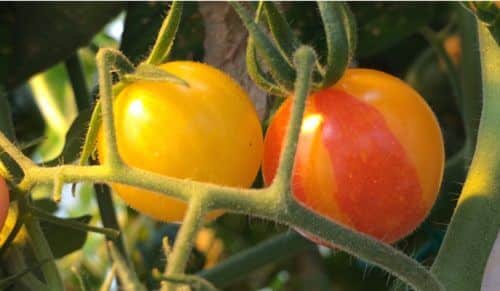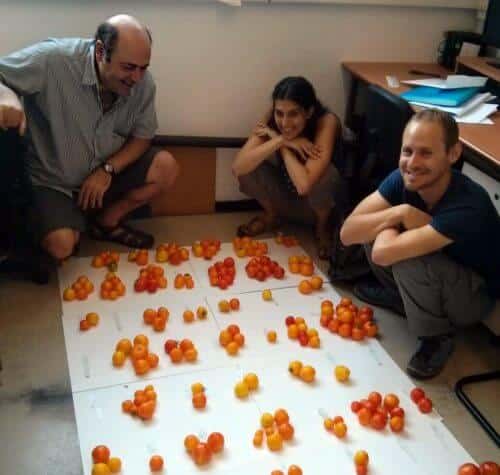How is it possible to produce fruits and vegetables that combine a fine taste with a great appearance?

Who doesn't know fruits and vegetables that look wonderful, but taste disappointing? How good it would be if growers could produce agricultural produce that is equally beautiful and tasty. The good news in this regard comes from the Weizmann Institute: its scientists have shown that this goal can be achieved with great precision by breaking the DNA of the plant in designated places. "This approach makes it possible not only to edit, but also to rewrite, the genome of the plant, in order to mix and combine, as needed, different traits from the two 'parents', including taste, size, yield and disease resistance," says Prof. Abraham Levy From the Department of Plant and Environmental Sciences. Prof. Levy carried out the research with the research student Dama Filar Hayut and the senior faculty scientist Dr. Kati Melamed-Basudo.
Although the genomes of many plants have already been deciphered, including tomato, wheat and banana, when breeders use this information to introduce changes in the genome, the results are often still random and unpredictable. The dream of the cultivators is to change the genome of plants in a more controlled manner, and to select traits from a limited number of plants and not from thousands, as is required with the existing technologies. Now it will probably be possible to do this with the help of creating fragments in the DNA of plants in a targeted location, and activating the healing and repair mechanisms of the plant itself.
When a break occurs in both helices of the DNA molecule, the repair proteins will often repair the damage by fusing the broken ends. However, there is another repair mechanism, called "homologous recombination", which takes advantage of the fact that the chromosomes come in pairs - one from each parent. In this process, the repair enzymes complete the missing piece at the break point by copying a segment of DNA from the other chromosome. Sometimes an exchange of DNA segments between the two chromosomes occurs in the process. That is, homologous recombination always leads to the transfer of DNA from one chromosome to another, but until now it was not possible to exploit this fact for the purpose of transferring desirable traits to the plant, because it was not known how often this type of repair occurs and how its location can be controlled.
asRecently reported in the scientific journal Nature Communications., the institute's scientists developed an original approach in order to track DNA repairs in a very tangible way: they genetically interfered in the process of creating the red pigment - lycopene - in tomatoes, without which the tomatoes remain yellow. In one series of experiments, the scientists created hybrid tomato plants containing one normal copy of the PSY1 gene, which is responsible for creating lycopene, on only one chromosome - while the other chromosome contained a defective copy of the PSY1. With the help of the CRISPR-Cas9 technology, which enables the cutting of the DNA at selected points with great precision, the scientists broke the two DNA helices in the normal copy of the PSY1 gene. As a result, in subsequent generations, many tomato plants had yellow fruit because they did not have a single normal copy of PSY1.

The scientists conducted a molecular analysis of the yellow fruits, and were able to determine what type of DNA repair was done in the plant's genes. They found that in most cases fusion of the two broken ends did occur, but in 14% of cases - a much higher rate than previously thought - homologous recombination occurred; That is, the break was repaired by copying a normal DNA segment from the intact chromosome to the broken chromosome. "After we showed that initiated homologous recombination occurs in such a high proportion of the cases, the cultivators can now take advantage of this mechanism for the purpose of developing new varieties," says Prof. Levy.
Philer Hayut explains: "Our research shows that in order to get a desired trait or a combination of traits in a plant in an accurate way, it is enough to choose the right parents, hybridize between them, and break the DNA in the hybrid plant in the desired genes. In the future, we can rely on the plant's natural repair mechanisms to copy the desired gene from the intact chromosome to the broken chromosome."
The scientists chose to work with a gene involved in the process of creating the red pigment in order to monitor the repair process, but the method is also valid for genes that encode any trait. "By breaking the two DNA helices, it is possible to design plants with a large number of traits in any possible combination," says Dr. Melamed-Bassoud.
And there is another advantage to the method: in most cases, the restrictions imposed on genetically modified food will not apply to it. Admittedly, it also includes genetic manipulations, but the final product is a plant that does not include genetic changes: the transfer of DNA occurs during a natural repair mechanism, and the genetic segments that motivated the process can be removed in future generations of plants.

4 תגובות
Who cares about the color of the tomato? What humanity urgently needs is lettuce produced by HTC.
my father
Improvement and royal selection are also genetic changes.
But it has been done for thousands of years.
Since the dawn of agriculture, man genetically engineers the plants and animals in his possession.
Not that there are no dangers in genetic engineering, but it is a mistake to rule out any genetic modification automatically
my father
seriously? Have you ever eaten a banana from nature? An orange from nature? Lettuce from nature?
Have you tried bread made from natural wheat?
The tastiest is what nature created.
Natural and organic and without the intervention of research institutes and without genetic engineering.
Although in the future it will be impossible because the genie is out of the bottle, the transgenic genes of the genetic engineering are also pollinated to the organic plants.
In my opinion, genetic engineering in agriculture will cause greater environmental damage in the future than global warming.